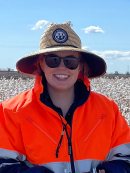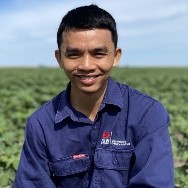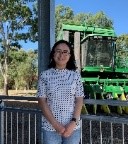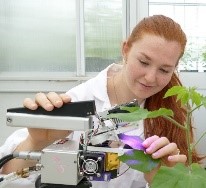Nominations for the AACS Early Career Scientist Encouragement Award and Scientific Publication Award are listed below (in alphabetical order).
The recipients of these awards together with our new Life Members and Service to Cotton Science Award will be revealed by ABC’s Land Line personality Pip Courtney at the conference dinner and awards ceremony on Wednesday 6 September.
AACS Early Career Scientist Encouragement Award
Congratulations to the following nominees for the AACS 2023 Early Career Scientist Encouragement Award:
 Dr Lucy Egan
Dr Lucy Egan
Dr Lucy Egan commenced as a Post Doctoral Fellow in the CSIRO Cotton Breeding Group in 2020 to work on a project to further develop cotton germplasm with increased host plant resistance (HPR) to pests and disease. Lucy has established herself as an excellent collaborator within the Cotton Breeding Group and other organisations such as Cotton Seed Distributors, QDAF, NSW DPI, Crown Analytical and SARDI.
Lucy has shown great creativity and innovation with her development of new Verticillium Wilt assays under controlled conditions using novel techniques. She has also been involved in cutting edge phenomics technology to quantify disease symptoms which will help underpin the selection of material cultivars for resistance in breeding lines. This technology will also enable farmers to identify the type of Vertillicium Wilt pathotype they have and can inform whether they should plant cotton or choose varieties with high levels of resistance.
Overall, Lucy has achieved much in the relatively short time she has been in the cotton industry. She displays genuine leadership skills together with a desire to collaborate widely across the industry. She is focused on achieving her project goals but also sees the bigger picture and is happy to put effort into achieving the overall goals of the cotton industry.
 Dr Duy Le
Dr Duy Le
Dr Duy Le completed his PhD in 2016 from The University of Queensland and commenced at ACRI as a cotton pathologist in July 2017. Duy has shown a strong enthusiasm towards research and industry service. His work has contributed to developing management approaches for major diseases including cotton black root rot (BRR), Wilt diseases and Alternaria leaf spot.
Duy collaborates with industry researchers from QDAF and Cotton Info team to monitor the occurrence and severity of cotton diseases on cotton farms. Duy has published a number of papers in high-impact peer-reviewed journals and regularly presents his finding to growers, consultants and peers at field days and events such as this conference. Since commencing with NSW DPI, Duy has become well established within pathology circles and he and his team provide diagnostic services to cotton growers, agronomists and consultants across the industry.
 Dr Xiaoqing Li
Dr Xiaoqing Li
Dr Xiaoqing Li finished her PhD in 2016 from Lancaster University (UK) in Plant Physiology to investigate plant root development and hormone signalling during soil drying. In 2020 Xiaoqing joined the Cotton Biotechnology group to work on novel cotton fibres through genetic engineering. She and her co-workers recently genetically engineered cotton fibre that produces a protein that does not exist naturally in cotton and so could be used to develop a way of tracing cotton back to its original source. In 2022 Xiaoqing and Madeline Mitchell et al. genetically engineered a dye-free naturally pink coloured cotton fibre by expressing a gene from Beetroot, which was published in the high profile ‘Plant Biotechnology Journal’ and paves the way for introducing new and difficult to dye colours into cotton.
Xiaoqing has a promising scientific career in front of her as the new co leader of the Cotton Core Biotech Project helping breeders to develop future elite lines.
 Dr Demi Sargent
Dr Demi Sargent
Dr Demi Sargent is currently a post-doctoral fellow at the Hawkesbury Institute for the Environment, Western Sydney University. Demi started her cotton research career by undertaking a summer scholarship at ACRI (CSIRO) with Warren Conaty in 2014/2015. Inspired by her experience with this program, Demi went on to enrol in a PhD in 2017 through ANU and CSIRO. Demi focused on discovering key resilience traits in cotton to fortify cotton production in the face of serious challenges posed by climate change and diminishing resources such as water and nitrogen. Following her PhD, Demi was awarded CRDC funding to continue her cotton research program to identify key traits to improve resilience to heat and water deficit conditions and begin to translate her key research findings. During this period Demi’s research efforts have been acknowledged through being the recipient of several awards, a notable example being the 2021 ABARES Science and Innovation Award for her work on Mesophyll Conductance and Abiotic Stress in Cotton
Demi has demonstrated excellence in cotton research and the ability to communicate with researchers in the field and also key industry stakeholders. She is an outstanding collaborator and has fostered collaborations with leaders in the field of photosynthesis and cotton production from ANU, QAAFi, CSD and USDA. Ultimately, Demi’s research will provide crucial insight into which biochemical traits will be required to improve cotton productivity. Demi is an emerging leader in cotton research and regularly communicates with key industry stakeholders her scientific advances.
AACS Scientific Publication Award
A strong field of publications were submitted for the 2023 award. Congratulations to the following contenders:
Antille, D. L., Moody, P. W. (2021). Nitrogen use efficiency indicators for the Australian grains, cotton, sugar, dairy, and horticulture industries. Environmental and Sustainability Indicators 10, Article number: 100099. https://doi.org/10.1016/j.indic.2020.100099.
Bange, M., Nunn, C., Mahan, J., Payton, P., Milroy, S., Finger, N., Caton, J., Dodge, W., & Quinn, J. (2022). Improving temperature-based predictions of the timing of flowering in cotton. Agronomy Journal, 114, 2728– 2742. https://doi.org/10.1002/agj2.21086
Hiz Jamali, Gunasekhar Nachimuthu, Blake Palmer, Darin Hodgson, Andy Hundt, Christopher Nunn, Michael Braunack (2021). Soil compaction in a new light: Know the cost of doing nothing – A cotton case study. Soil and Tillage Research Volume 213 ISSN 0167-1987,
https://doi.org/10.1016/j.still.2021.105158 (https://www.sciencedirect.com/science/article/pii/S0167198721002312
Le DP, Nguyen CPT, Kafle D, Scheikowski L, Montgomery J, Lambeth E, Thomas A, O’Keeffe K, Shakeshaft B, Young A, Mckay A, Twine A, Hudson E, Jackson R, Smith LJ (2022) Surveillance, Diversity and Vegetative Compatibility Groups of Fusarium oxysporum f. sp. vasinfectum Collected in Cotton Fields in Australia (2017 to 2022). Pathogens 11:1537
Xiaoqing Li, Madeline Mitchell, Vivien Rolland, Sue Allen, Colleen MacMillan, Filomena Pettolino (2022). ‘Pink cotton candy’—A new dye-free cotton https://doi.org/10.1111/pbi.13990 https://onlinelibrary.wiley.com/doi/epdf/10.1111/pbi.13990
McCarthy, A., Foley, J., Raedts, P. and Hills, J. (2023). “Field evaluation of automated site-specific irrigation for cotton and perennial ryegrass using soil-water sensors and Model Predictive Control.” Agricultural Water Management. 277, pp. 1-17. https://doi.org/10.1016/j.agwat.2022.108098
Nachimuthu, G., Schwenke, G., Mercer, C., Bischof, C., Hulme, P., & Bell, M. (2022). A review of phosphorus nutrition in irrigated cotton farming systems of Australia. Journal of Cotton Research, 5(1), 1-8. https://doi.org/10.1186/s42397-022-00114-x
Rolland, V., Farazi, M.R., Conaty, W.C. et al. HairNet: a deep learning model to score leaf hairiness, a key phenotype for cotton fibre yield, value and insect resistance. Plant Methods 18, 8 (2022). https://doi.org/10.1186/s13007-021-00820-8
Zhu, Q. H., Stiller, W., Moncuquet, P., Gordon, S., Yuan, Y., Barnes, S., & Wilson, I. (2021). Genetic mapping and transcriptomic characterization of a new fuzzless-tufted cottonseed mutant. G3, 11(1), jkaa042.